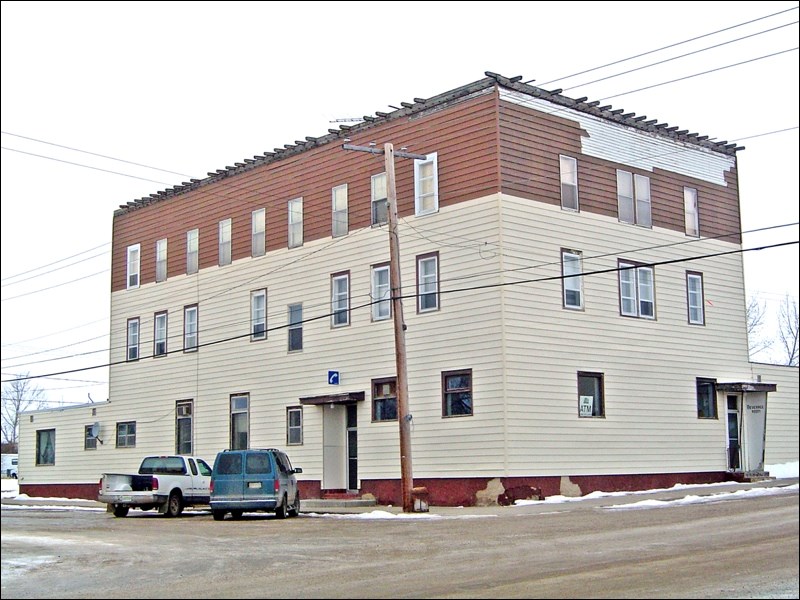When the Canadian Northern Railway arrived at Dinsmore in 1913, it brought with it 12 railway cars of lumber for the construction of a hotel, built by T.W. McCrea & Delisle Bros. at a cost of about $25,000. The following, written by Bill Davidson for Dynamic Dinsmore (1979), is one of the most complete descriptions I have found of a small-town Saskatchewan hotel.
“The hotel was a well-built frame structure of 3 storeys on a full-size basement, 41’ x 75’ and 35’ high, covered with cedar siding and a flat roof paper composition with a 1-3 slope. The original structure had a false front extending around 3 sides, open at the back (north side). It has always been painted cream with brown trim. Other buildings built at this time in connection with the hotel were a buggy shed, a stable with a loft, a chicken house which later became an ice house.
“The interior was lathed and plastered and calsomined most vivid colours. The trim and doors were fir and very darkly stained. The ground floor comprised of two small rooms for the proprietor’s dwelling, a pantry, large kitchen and large dining room, a very large rotunda with a horseshoe counter facing the stairway, and a huge sitting area. A portion of this was used as barber shop and a small room at the N.E. corner was a saloon, but used as a confectionery, lunch counter and store over the years. The first floor comprised of 14 bedrooms and the [third] floor 17 bedrooms. Total 31 rooms. The rooms weren’t all that large especially when two beds were put in some. Each floor has a very wide hallway 12 feet. The rooms were originally furnished with brass beds 48’ or 36’, a chair or two, a dresser or a combination dresser and wash stand, and one 60-watt light bulb in the center of each room, also a china pitcher, basin and thunder mug.
“The original toilet system was built onto the N.W. corner of the hotel – a 12 x 12 addition comprising of two toilets on each guest floor and directly below sat the traditional known honey wagon – a 300 gallon tank on a horse-drawn wagon that had to be emptied regularly. There was a back stairway from top to bottom coming down into the kitchen. Also, each room had a cotton rope coiled up beneath the window to be used in case of fire. … All the floors were fir, except the kitchen, which was white hardwood and had to be scrubbed regularly. Eventually, some of the floors were covered with congoleum, linoleum, tile, etc.
“The lighting system built into the hotel was an English Lister lighting plant 32-volt plus glass storage batteries. There was a gasoline engine in the basement with an outside exhaust, which had to be started each day at dawn and shut off at 11 p.m. when everyone was supposed to be in bed. If the plant wasn’t working properly the lights were very dim. When Dad took over [Tom Davidson in 1930], he doubled the number of storage batteries and installed a wind charger to keep them charged. This helped save the old plant. In 1948, Dad hooked up with SaskPower, and after a lot of rewiring we could use an electric iron, bed lamps, hot water, heaters, refrigeration, air conditioning, etc.
“The heating system comprised of a sectional cast iron steam boiler, a one-pipe system piped throughout the building connecting to a cast iron steam radiator in each room, two in the larger rooms. It had to be hand-fired with coal and wood, so that was an annual job putting a car of wood and coal in the basement every fall. The boiler was in bad shape when Dad bought the hotel, so stoves were installed here and there to keep warm.”
Bill and Grace Davidson took over the Dinsmore Hotel when Bill’s parents retired in 1953. They still owned the hotel when Bill wrote the above article in 1979. It remains a community landmark to this day.



